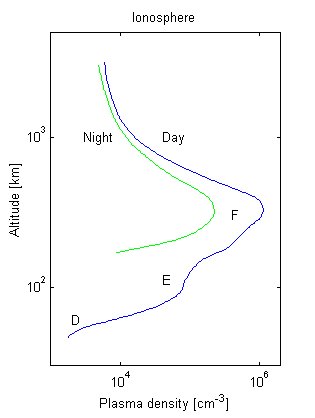 Ionosphere
(Earth's)
Ionosphere
(Earth's) Ionosphere
(Earth's)
Ionosphere
(Earth's)spaceweb@oulu.fi - last update: 25 November 1998, 0830 UT (RR)
Because of the Sun 's UV radiation, Earth 's upper atmosphere is partly (0.1% or less) ionized plasma at altitudes of 70-1500 km. This region, ionosphere, is coupled to both the magnetosphere and the neutral atmosphere. It is of great practical importance because of its effect on radio waves.
The existense of a conducting layer in the upper atmosphere results also in many other interesting phenomena. Around the plasma density maximum (F-layer, see below) a so-called ionospheric waveguide is formed for magnetosonic waves. In addition, a so-called ionospheric Alfvén resonator (IAR) can be formed between the density maximum and an upper altitude at about 3000 km, where the Alfvén velocity has a maximum. A third natural resonator is formed between the nearly perfectly conducting terrestrial surface and the ionosphere, creating the so-called Schumann resonances
 Ionization appears
at a number of atmospheric levels, producing layers or regions which may be identified by
their interaction with radio waves. These layers are known as the D, E, and F layers, and
their locations are shown in the figure for both night and day conditions at
mid-latitudes.
Ionization appears
at a number of atmospheric levels, producing layers or regions which may be identified by
their interaction with radio waves. These layers are known as the D, E, and F layers, and
their locations are shown in the figure for both night and day conditions at
mid-latitudes.
The first ionospheric layer found was the so called E layer or region at about 110 km altitude. It is used by radio operators as a surface from which signals can be reflected to distant stations. It is interesting to note that this works also the other way round and, for example, the auroral kilometric radiation created by the precipitating particles high above the ionosphere does not reach the ground because of the ionospheric E layer. Above the E layer, a F layer consisting of two parts can be found: F1 is at about 170 km, and F2 at about 250 km altitude. Also F layer reflects radio waves. The lowermost region of the ionosphere below 80 km altitude, D layer, however, principally absorbs radio waves.
Within the auroral oval the nighttime E layer plasma densities can be much higher than indicated by the figure. Densities are also very variable because of the spatial and temporal strucuture in the ionizing particle precipitation. The E layer plasma density profiles can also be drastically altered due to the occasional formation of so-called sporadic E layers.
In F layer altitudes one encounters such features as polar cap ionization patches and different types of troughs.
Note also that there is also a clear solar cycle effect seen: the average densities are higher during solar maximum years than during the minimum years.
...
The electron temperature responds readily to the auroral precipitation with a strong increase. Ion temperatures, on the other hand, are elevated mainly by frictional heating due to strong electric fields. The electric field can increase E layer electron temperature only indirectly via instabilities it creates (see radar aurora).
Ionospheric electric fields are the main result of the coupling between the magnetosphere and ionosphere. While at low-latitudes the ionospheric plasma is co-rotating with the Earth, at higher latitudes it is convecting under the influence of the large scale magnetospheric electric field mapped to low altitudes. The Harang discontinuity is one of the ionospheric features related to the plasma convection pattern.
The convection pattern leads to ionospheric Hall currents (see E x B drift), and along the auroral oval so-called convection electrojets are formed at about 100 km altitude: eastward electrojet on the duskside, westward on the dawnside. Historically a term DP-2 has also been used (disturbance polar of the second type).
The coupling between the ionosphere and magnetosphere results also into large and small scale field-aligned currents (FAC). As the down- and upward parts of the current systems are typically separated, horisontal current systems must be formed within the conducting ionosphere. The auroral (or substorm) electrojet, earlier known as the DP-1 current (disturbance polar of the first type), relates to the formation of substorm current wedge.
One of the best instruments to study ionosphere with is the incoherent scatter radar, of which EISCAT is a good example. Plasma instabilities are best studied with coherent scatter radars, and ionosondes are still used continuously to monitor ionospheric processes. Ionospheric currents are traditionally been studied by magnetometers.
See also
and